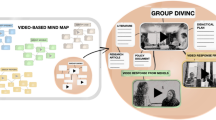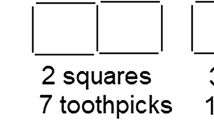Abstract
This paper examines a series of instructional activities that provide prospective elementary teachers with an opportunity to engage in one of the more difficult practices to learn within mathematics teaching—organizing a mathematical discussion. Within a mathematics methods course, representations and decomposition of practice built from the Five Practices framework (Smith and Stein in Five practices for orchestrating productive mathematics discussions. Corwin Press, Thousand Oaks, CA, 2011) were implemented and studied to examine how prospective elementary teachers set goals, selected and sequenced available student work, and planned questions within a mathematical discussion. We examined prospective elementary teachers’ strengths and weaknesses in these facets through an approximation of practice set in a lesson context familiar to the prospective elementary teachers. Our results demonstrated that although prospective elementary teachers set varying goals for a discussion, their pedagogical choices in planning their discussion tended to be consistent with the goals they have set. These results support the focused development of prospective elementary teachers’ goal setting as an implication for mathematics teacher educators.
Similar content being viewed by others
Notes
In using the term Standards-based curriculum, we are referring to the curriculum materials funded by the National Science Foundation and aligned with the NCTM Standards.
References
An, S., Kulm, G., & Wu, Z. (2004). The pedagogical content knowledge of middle school, mathematics teachers in China and the US. Journal of Mathematics Teacher Education, 7(2), 145–172.
Anghileri, J. (2006). Scaffolding practices that enhance mathematics learning. Journal of Mathematics Teacher Education, 9(1), 33–52.
Ball, D. L., Thames, M. H., et al. (2008). Content knowledge for teaching: What makes it special? Journal of Teacher Education, 59(5), 389–407.
Baumert, J., Kunter, M., Blum, W., Brunner, M., Voss, T., Jordan, A., et al. (2010). Teachers’ mathematical knowledge, cognitive activation in the classroom, and student progress. American Educational Research Journal, 47(1), 133–180.
Brown, C. A., & Borko, H. (1992). Becoming a mathematics teacher. In D. A. Grouws (Ed.), Handbook of research on mathematics teaching and learning. New York: MacMillan.
CCSSO & NGA (2010). Common core state standards for mathematics.
Chamberlain, M. T. (2005). Teachers’ discussion of students’ thinking: Meeting the challenge of attending to students’ thinking. Journal of Mathematics Teacher Education, 8, 141–170.
Chazan, D., & Ball, D. (1999). Beyond being told not to tell. For the learning of mathematics, 19(2), 2–10.
Cobb, P., Confrey, J., di Sessa, A., Lehrer, R., & Schuable, L. (2003). Design experiments in educational research. Educational Researcher, 32(1), 9–13.
Crespo, S. (2003). Learning to pose mathematical problems: Exploring changes in preservice teachers’ practices. Educational Studies in Mathematics, 52, 243–270.
Drake, C., Land, T. J., Franke, N., Johnson, J., & Sweeney, M. (in press). Teaching elementary mathematics for understanding. NCTM.
Franke, M. L., Webb, N. M., Webb, A. G., Ing, M., Freund, D., & Battey, D. (2009). Teacher questioning to elicit students’ mathematical thinking in elementary school classrooms. Journal of Teacher Education, 60(40), 380–392.
Ghousseini, H. (2009). Designing opportunities to learn to lead classroom mathematics discussions in pre-service teacher education: Focusing on enactment. Scholarly Practices and Inquiry in the Preparation of Mathematics Teachers, 203–218.
Goos, M. (2004). Learning mathematics in a classroom community of inquiry. Journal for Research in Mathematics Education, 35(4), 258–291.
Grossman, P., & McDonald, M. (2008). Back to the future: Directions for research in teaching and teacher education. American Educational Research Journal, 45(1), 184–205.
Grossman, P., Compton, C., Igra, D., Ronfeldt, M., Shahan, E., & Williamson, P. (2009). Teaching practice: A cross-professional perspective. The Teachers College Record, 111(9), 2055–2100.
Hill, H. C., Ball, D. L., & Schilling, S. G. (2008). Unpacking pedagogical content knowledge: Conceptualizing and measuring teachers’ topic-specific knowledge of students. Journal for Research in Mathematics Education, 39(4), 372–400.
Hill, H. C., Sleep, L., Lewis, J. M., & Ball, D. L. (2007). Assessing teachers’ mathematical knowledge: Why knowledge matters. In F. K. Lester (Ed.), Second handbook of research on mathematics teaching and learning (Vol. 1, pp. 111–156). Charlotte, NC: Information Age Publishing.
Kazemi, E., Franke, M., & Lampert, M. (2009). Developing pedagogies in teacher education to support novice teachers’ ability to enact ambitious instruction. In: Crossing divides: Proceedings of the 32nd Annual Conference of the Mathematics Education Research Group of Australasia (Vol. 1, pp. 12–30).
Kennedy, M. M. (1999). The role of preservice teacher education. In L. Darling-Hammond & G. Sykes (Eds.), Teaching as the Learning Profession: Handbook of Teaching and Policy (pp. 54–86). San Francisco: Jossey Bass.
Lampert, M. (1990). When the problem is not the question, and the solution is not the answer: Mathematical knowing and teaching. American Educational Research Journal, 27(1), 29–63.
Lampert, M., Beasley, H., Ghousseini, H., Kazemi, E., & Franke, M. (2010). Using designed instructional activities to enable novices to manage ambitious mathematics teaching. In M. K. Stein & L. Kucan (Eds.), Instructional explanations in the disciplines. New York: Springer.
Lampert, M., & Blunk, M. L. (Eds.). (1998). Talking mathematics in school: Studies of teaching and learning. Cambridge, UK: Cambridge University Press.
Lampert, M., & Graziani, F. (2009). Instructional activities as a tool for teachers’ and teacher educators’ learning. The Elementary School Journal, 109(5), 491–509.
Lampert, M., Franke, M. L., Kazemi, E., Ghousseini, H., Turrou, A. C., Beasley, H., et al. (2013). Keeping it complex using rehearsals to support novice teacher learning of ambitious teaching. Journal of Teacher Education, 64(3), 226–243.
Lau, P. N. K., Singh, P., & Hwa, T. Y. (2009). Constructing mathematics in an interactive classroom context. Educational Studies in Mathematics, 72(3), 307–324.
Leech, N. L., & Onwuegbuzie, A. J. (2007). An array of qualitative data analysis tools: A call for data analysis triangulation. School Psychology Quarterly, 22(4), 557–584.
Lobato, J., Clarke, D., & Ellis, A. B. (2005). Initiating and eliciting in teaching: A reformulation of telling. Journal for research in mathematics education, 101–136.
Manouchehri, A., & Enderson, M. C. (1999). Promoting mathematical discourse: Learning from classroom examples. Mathematics Teaching in the Middle School, 4(4), 216–222.
National Council of Teaching Mathematics. (2000). Principles and standards for school mathematics. Reston, VA: National Council of Teaching Mathematics.
Nicol, C. (1998). Learning to teach mathematics: questioning, listening, and responding. Educational Studies in Mathematics, 37(1), 45–66.
Pirie, S. E. B., & Schwarzenberger, R. L. E. (2000). Mathematical discussion and mathematical understanding. Educational Studies in Mathematics, 19(4), 459–470.
Shulman, L. S. (1986). Those who understand: Knowledge growth in teaching. Educational Researcher, 15(2), 4–14.
Sleep, L. (2012). The work of steering instruction toward the mathematical point a decomposition of teaching practice. American Educational Research Journal, 49(5), 935–970.
Smith, M. S., Bill, V., & Hughes, E. K. (2008). Thinking through a lesson: Successfully implementing high-level tasks. Mathematics Teaching in the Middle School, 14(3), 132–138.
Smith, M., & Stein, M. K. (2011). Five practices for orchestrating productive mathematics discussions. Thousand Oaks, CA: Corwin Press.
Stein, M. K., Engle, R. A., Smith, M. S., & Hughes, E. K. (2008). Orchestrating productive mathematical discussions: Five practices for helping teachers move beyond show and tell. Mathematical Thinking and Learning, 10(4), 313–340.
Strauss, A., & Corbin, J. (1998). Basics of qualitative research: grounded theory procedures and techniques. Thousand Oaks, CA: Sage.
TERC. (2008). Investigations in number, data, and space. Glenview, IL: Pearson/Scott Foresman.
Tyminski, A. M., Drake, C., & Land, T.J. (2010). Pre-service teachers’ learning about and from standards-based curriculum materials: The case of addition starter sentences. In P. Brosnan, D. B. Erchick & L. Flevares (Eds.), Proceedings of the 32nd Annual Meeting of the North American Chapter of the International Group for the Psychology of Mathematics Education (Vol. 6, pp. 1174–1182). Columbus, OH: The Ohio State University.
Tyminski, A. M., Drake, C., & Land, T. J. (2013) Developing addition strategies: Pre-service teachers' learning from standards-based curriculum materials. Mathematics Teacher Educator, 2(1): 6–26.
Tyminski, A. M., Land, T. J., & Drake, C. (2011). Elementary preservice teachers’ critiques, comparisons, and preferences in examining standards-based curricular materials. In L. R. Wiest & T. Lamberg (Eds.), Proceedings of the 33rd Annual Meeting of the North American Chapter of the International Group for the Psychology of Mathematics Education. Reno, NV: University of Nevada, Reno.
Tyminski, A. M., Land, T. J., & Drake, C., Zambak, V. S., & Simpson, A. (in press). Pre-service elementary mathematics teachers’ emerging abilities to write problems to build on student’s thinking. In J. Lo, K. R. Leatham & L. R. Van Zoest (Eds.), Research trends in mathematics teacher education. New York: Springer.
UCSMP. (2007). Everyday mathematics: The University of Chicago School Mathematics Project. Chicago: McGraw Hill.
Acknowledgments
This work was supported, in part, by the National Science Foundation under NSF Grant No. 0643497; Corey Drake, PI. Any opinions, findings, conclusions, or recommendations expressed in this material are those of the authors and do not necessarily reflect the views of the National Science Foundation.
Author information
Authors and Affiliations
Corresponding author
Appendices
Appendix 1: NOTD presentation
In your groups, you will facilitate a NOTD task to your colleagues. Each NOTD task should build on a previous NOTD. In other words, choose a concept that was addressed in a previous NOTD and expand on it in your NOTD. Before you present your NOTD, answer questions 1–5 to help you plan. On your assigned day, you will facilitate NOTD. After NOTD, respond to questions 6–9. All responses are due a week after you present. One response from each group will suffice. Make sure to list all group members on the document.
Before NOTD
-
1.
What is your NOTD and rationale for that particular number?
-
2.
What are your parameters (e.g., only addition sentences) and rationale?
-
3.
What is your goal for NOTD?
-
4.
Generate a list of expressions you anticipate will be given by your colleagues. (Note: While your colleagues are actually generating the expressions, you may want to cherry-pick the responses you want shared during the discussion by marking them with a star on their paper.)
-
5.
Generate a list of questions to ask your colleagues after they provide their expressions. (Note: If none of your anticipated expressions are generated, you may have to come up with new questions.)
After NOTD
-
6.
Did your anticipated expressions match the ones that were given? Explain.
-
7.
What questions was your group able to ask?
-
8.
What is a question that you wished your group asked but didn’t. Why?
-
9.
Do you feel that you met the learning goal? Explain.
Appendix 2
Students’ strategies for 349 + 175

Rights and permissions
About this article
Cite this article
Tyminski, A.M., Zambak, V.S., Drake, C. et al. Using representations, decomposition, and approximations of practices to support prospective elementary mathematics teachers’ practice of organizing discussions. J Math Teacher Educ 17, 463–487 (2014). https://doi.org/10.1007/s10857-013-9261-4
Published:
Issue Date:
DOI: https://doi.org/10.1007/s10857-013-9261-4




